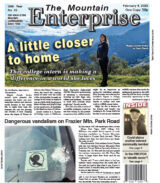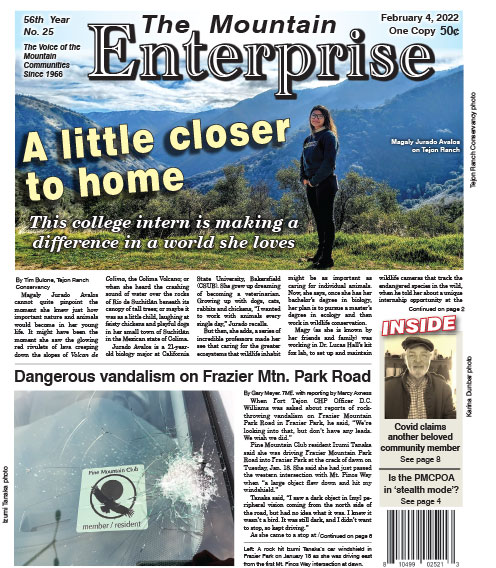The Mountain Enterprise reported in November 2019 that timber industry groups intervened in the case on behalf of the U.S. Forest Service—after USFS representatives in the Los Padres National Forest administration told residents of the Mountain Communities that the projects were not commercial logging concessions. With their “friend of the court” filing, the logging industry organizations contradicted what the local public was told by the USFS. The American Forest Resource Council argued that the timber industry does indeed have “an economic interest at stake in this case” due to their “direct interests in the economic benefits from the implementation of the Tecuya Project.”
The LPFW press release reports that the USFS “awarded a contract to an Oregon-based company last year [2021] to do much of the tree cutting as part of the Tecuya Ridge project, and work was scheduled to begin later this month.”
The Ninth Circuit’s 2-1 ruling will now go back to the U.S. District Court in Los Angeles for reconsideration. That is where, in 2020, a judge ruled against the environmental plaintiffs. The primary difference between that ruling and the appeal reversal is that the appeal panel this week said that for the USFS to claim that the proposed Tecuya Ridge project complies with the federal Roadless Area Conservation Rule is “arbitrary and capricious.”
The second, and related, verdict by the same panel this week is the appeal about Cuddy Valley—Mountain Communities for Fire Safety et al. v. U.S. Forest Service. It ended in the opposite direction, also with a 2-1 decision, upholding the USFS approval of a 1,200-acre logging project adjacent to the Tecuya Ridge Project.
In 2020, the Los Padres Forest Watch and John Muir Project argued against the USFS use of a categorical exclusion as “a loophole designed for timber stand and wildlife habitat enhancement” to justify the Cuddy Valley thinning project.
This week’s Ninth Circuit appeal panel agreed 2-1 with the USFS arguments that they have been given wide latitude in the law to decide which projects qualify for the categorical exclusion loophole.
Judge Sidney H. Stein characterized his Ninth Circuit appeal panel colleagues’ decision as a “novel interpretation” because it “would allow the Forest Service to approve commercial thinning of trees—in other words, to contract with private logging companies to cut and then sell large trees—over a potentially unlimited number of acres.”
The plaintiffs have stated that categorical exclusions employ administrative end-runs to avoid the public debate process. That debate is primarily between those who view the national forests as a place for “harvesting timber” and those who argue for the value of “preserving healthy habitat” for plant and animal species.
The widespread use of categorical exclusions increased dramatically during the Trump Administration to avoid providing the public full notification, public hearings and debate about the findings of an environmental impact assessment study of the consequences of such projects. The National Environmental Policy Act (NEPA) was established to safeguard the public’s right to know and to debate these issues when a project of this size (over 2,400 acres) is proposed. The footprint of the project is due to jump by another 2,000 acres with the addition of the Mount Pinos project proposed last year, which was not brought up in these two lawsuits. In essence, the USFS has the plan to “thin” over 4,100 acres of local forest by pretending that this is not one very large project, but is three separate projects—all to evade the NEPA mandate to provide environmental impact assessments and meaningful public hearings.
The concern about this issue is compounded with the accelerating impacts of climate change, and the hurricane force winds that are changing fire behavior dramatically in America’s West. The newest research of the behavior of the catastrophic fires of the last five years is contradicting research from the last century—upon which most the USFS arguments are based. In today’s conditions, large trees, both living and snags, are seen in many cases to slow the momentum of fires rather than to serve as accelerants. The rush to use the public’s fear of wildfire to “sell” logging projects, opponents say, seeks to sidestep the law, to avoid providing the open public debate mandated by following NEPA procedures.
Judge Stein wrote that the Cuddy Valley verdict is inconsistent with Supreme Court precedent, and “contravenes the very purpose of NEPA” that is designed to ensure that significant environmental impacts are minimized.
In his press release, Baker quotes the closing statement in Judge Stein’s dissent to the Cuddy Valley ruling: “By failing to consider the consequences of allowing the Forest Service to evade NEPA’s environmental disclosure requirements for projects involving significant amounts of commercial thinning—projects that are outside the scope of activities [that Categorical Exclusions] are meant to authorize—the majority misses the forest for the trees and does an impermissible disservice to NEPA’s regulatory scheme and the law.”
This is part of the February 4, 2022 online edition of The Mountain Enterprise.
Have an opinion on this matter? We'd like to hear from you.


